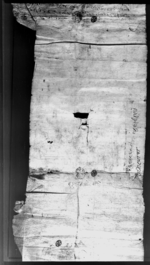A rukkā from King Surendra to the jogīs of the Bārhapantha re the ānāmānā payment and the funding of patrapūjā (VS 1896)
ID: K_0471_0014
Edited and
translated by Christof Zotter
Created: 2017-02-07;
Last modified: 2018-06-15
For the metadata of the document, click here
The accompanying edition, translation/synopsis and/or commentary are available under the terms of the Creative Commons Attribution-ShareAlike 4.0 International License
Abstract
In response to a complaint by the maṇḍalī Bholanātha over disruption in the customary payment of certain levies to the Bāhrapantha, this executive order of King Surendra, addressing the jogīs of the Bāhrapantha, orders that, as before, the darāis, kumāles and danuvāras shall provide the ānāmānā payment and the mājhīs shall fund the patrapūjā.Diplomatic edition
[1r]
[...][royal seal]1स्वस्तिश्रीमन्महाराजाधिराजकस्यरुक्का¯ ¯ ¯ ¯ ¯ ¯ ¯ ¯2आगे•वार्हपंथजोगिहरूके•हाम्राभरमुलुककाकुमालदरईद
3नुव़ारलेआनामानाघाटकामाझिहरूलेपत्रपूजाहिजैदेषिवार्ह
4पंथलाईतीमीहरूलेतीरिआयाकोहोवीचमाअटकाईदीय़ाभ
5निमंडलीभोलानाथजोगिलेहाम्राहजूरमावींतीगर्दाजाहेरभ
6योतसर्थवार्हपंथिजोगिकोरकम्पत्रपूजारआनामानाअट
7क्याकोफुकाइवक्स्यौंदराईकुमालदनुव़ारलेआनामानाघाटका
8माझिहरूलेपत्रपूजावार्हपंथलाईषसोषासभरिदेउ•जसले
9षिचलागर्लासोअपसरियाहोला•ईतिसम्वत१८९६सालमितिमा
10घसुदि४रोज५शुभम्
[1v]
⟪[two seals]⟫1[...]साहः2रूजूतारानाथअर्ज्याल्•रूजूकरवीरपाँडे
3[...]रणजोरथापा⟪[two seals]⟫
Translation
[1r]
[Venerable Durgājyū] 1
[royal seal]
Hail! [This is] an executive order of the supreme king of great kings.
To: the jogīs (of the) Bārhapantha
Since earlier times (lit. yesterday), the darāis, kumāles [and] danuvāras of our whole country have been customarily paying ānāmānā2 , [and] the mājhīs of the ghats [the expenses] for the patrapūjā3 to the Bārhapantha. 4 It came to [our] notice when the maṇḍalīBholānātha Jogi made petition to us that [these payments] have since been halted. Therefore, we will undo (phukāibaksyaũ) 5 the bārhapanthi jogīs' revenue (rakam), patrapūjā and ānāmānā [all] having come to a halt. The darāis, kumāles and danuvāras shall properly (khasokhāsa) make full [payment of] the ānāmānā [and] the mājhīs of the ghats [that for] the patrapūjā, to the Bārhapantha. He who holds back on full [payment] will be [considered] a rebel (apsariyā).
Thursday, the 4th of the bright fortnight of Māgha of the [Vikrama] era year 1896 (1840 CE). Auspiciousness.
[1v]
[two seals]6
[...]7 Sāha
attested: Tārānātha Arjyāl; 8 attested: Karavīra Pā̃ḍe
[...]9 Raṇajora Thāpā
[two seals]
Commentary
Also available in the Guṭhī Saṃsthāna (Pokā no. 10, 60/84, Bha. Gu. La. Ja. [Guṭhī Lagata Jā̃ca], Ms. no. 1) is a copy of the rukkā, assented to by the abbot (pīramahanta) of Mṛgasthalī, Dhārīnātha (in office 1905-16). It was filmed by the NGMPP twice, under reel-nos. K 44/67E and K 440/12 (see K_0440_0012). Another copy (Pokā no. 10, 60/84, Bha. Gu. La. Ja., Ms. no. [?]), assented to by abbot (pīrajī) Nārānnātha, was filmed under reel-no. NGMPP K 451/58 (see K_0451_0058) .
In earlier documents regarding the privileges of the central overseer (maṇḍalāi) of jogīs (for references, see K_0469_0009), the darāis, kumāles, danuvāras and mājhīs (without any further specifications) along with a number of other ethnic or professional groups (jāta) are ordered to pay one ānā per household as a customary fee (dastura) and to offer food (to the jogīs) morning and evening. In these documents, neither is the institution of the Bārhapantha mentioned, nor is a distinction made between different levies assigned to specific groups.
Not much is known about the life of the darāis, kumāles and danuvāras at that time or about the reasons for the conflict the rukkā was meant to resolve. Fortunately, at least with regard to the mājhīs of the ghats, the fishermen who were obliged to provide ferry services and transportation of mail and supplies under the hulāka system, some information is available that helps to explain the situation. M.C. Regmi 1978: 95f. (with reference to RRC 34: 516f.) summarizes a complaint of the mājhīs of "Syalpa Ghat" that was made to the government just two years before the present document. 10 As the headmen (mījhāra) of the mājhīs reported, four of the eleven mājhī families had left the place after a flood washed away their land in Benitar, and the remaining families, having no adequate means of livelihood and lacking any fiscal concessions, were not able to stay and provide services anymore. According to Regmi (ibid.: 96), the government thereupon evicted tenants on jagīra land (land assigned as an emolument) in Khurkot and allotted it to the remaining mājhī families. Furthermore, the mājhīs were exempted from the obligation to provide unpaid labour services (jhārā, beṭha, begāra) for other purposes, and from the payment of the maṇḍalī levy for the jogīs.
A similar case is documented in a rukkā (filmed under reel-no. NGMPP E 3416/9) to the mājhīs of Paiṅyũ Ghāṭa and their mījhāra, dated Sunday, the 5th day of the bright fortnight of Māgha of the [Vikrama] era year 1895 (1839 CE). In order for them to "operate the river landings" (ghāṭa calāunu), pākho land was assigned to the mājhīs as kipaṭa. The addressees had to pay sermā and sāunyāphāgu but were granted an exemption from supplying other revenues (aru rakaṃ mārīmeṭī māpha baksī). As the royal edict to the jogīs of the Bārhapantha issued in the following year shows, such concessions were not permanent, but could be reversed without prior notice.


